Financial planner: 'We’re not out of the woods yet'
Hope for the best, plan for the worst.
That’s the best way to successfully build wealth for retirement these days, Anthony Saccaro, president at Providence Financial & Insurance Services, recently told Yahoo Finance Live (video above). "I want my clients to plan for the worst-case scenario."
Why so glum?
"It's likely there is going to be a [market] correction," said Saccaro, author of "More Life Than Money: How Not to Outlive Your Savings". "We're not out of the woods yet."
He added: "I caution everyone that a recession could still be around the corner."
To be sure, economic uncertainty has been top of mind for months. For instance, the Fitch Ratings agency last week lowered the US sovereign debt rating to AA+ from its top score of AAA, sending the market into a freefall for the week. (Stocks rebounded Monday.) Also, the Bureau of Labor Statistics' data showed a continued cooling in the labor market.
More potential so-so news: this week's July inflation report and the inevitable guessing game of whether the Fed will push interest rates higher in September.
Saccaro’s remedy for his clients is a slow and steady approach to piecing together a robust retirement portfolio.
Read more: Top savings tools: 4 alternatives to savings accounts
Dividends, anyone?
For Saccaro, that means focusing on income-producing investments such as dividend-paying stocks — or a mutual or exchange-traded fund that owns dividend-paying stocks.
"The fact is there are long periods of time where the market has no growth followed by long periods... where the market does really well," he said. "And we've just come out of a 13-year period, starting in 2009 where the market's done really, really well and a lot of analysts — a lot of professionals, including myself — are thinking that the next decade may not be so good."
If you’re a retiree, you "want to be living on the interest and dividends, so you're not cannibalizing your principal," Sacarro said. And if you’re in the accumulation phase of life and growing your portfolio, it’s a great strategy.
"The dividends allow you to get paid while you wait so you can grow your portfolio through dollar cost averaging the dividends back in," said the Woodland Hills, CA-based financial advisor.
In essence, you turn your cash dividends into more shares of stock over time.

How much in stocks?
Folks with 10 or more years until retirement can be more aggressive with a bigger portion of their retirement savings invested in stocks, he said.
"If you have 10 years or less of retirement, you need to start pulling back. And if you are retired, you have to really focus on income. At least cover your income needs through dividends and interest, and then you can invest the rest a little more aggressively if you want to."
One big mistake retirees make is they wait until the day before they retire to make a change to less volatile investments — like bonds, and "for the last decade and a half, they've gotten away with it. But for the next decade and a half, maybe not," he added.
The standard advice for those who have decades ahead until retirement is to own stocks. Here's the math: Take 100 or 110 minus your age, and that’s the percentage of your retirement savings that should be invested in equities.
Saccaro said: "The question really goes back to what stage of life are you in? The whole point of 60% stocks, 40% bond portfolio is if the 60% drops, the 40% goes up. If the 40% drops, the 60% goes up. The 40% provides more income."
Read more: CDs vs. bonds: Which is right for me?
For those who are older, flipping that around makes sense. "Maybe even going to a 40/60 portfolio, 30/70 portfolio if you're living on your income, and you've got to be more conservative," he said. "But if you're in that accumulation phase of life, you can even go more aggressive than that 60/40."
And within stocks, that may play out as owning several different types of stocks: large caps, mid caps, and small caps. Bonds may include US government and international bonds.

Avoid hot-stock hunting
Saccaro, meanwhile, isn't keen on investors who frenetically search for the next big thing.
"We're getting a lot of questions about the AI craze," he said. "A lot of investors want to know ‘how do I get in on that? What's one company? What's the Apple that I can buy that in 10 years is going to take my $10,000 and make it millions of dollars, like it would have been if you'd have bought Apple 30 or 40 years ago?’"
His answer: "I'm going to just caution you, don't chase a company. You want to consider AI and what companies are doing with AI, but you've got to be really careful."
-
Kerry Hannon is a Senior Reporter and Columnist at Yahoo Finance. She is a workplace futurist, a career and retirement strategist, and the author of 14 books, including "In Control at 50+: How to Succeed in The New World of Work" and "Never Too Old To Get Rich." Follow her on Twitter @kerryhannon.
Read the latest financial and business news from Yahoo Finance
